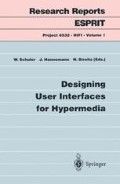Abstract
In pharmaceutical industry, each new drug is tested in clinical studies before it is released on the market. Any adverse event occurring in such a study requires a difficult decision: Is the event caused by the drug under investigation or by other factors? The human decision maker trying to answer this question faces a complex problem and must consider a multitude of heterogeneous data and numerous knowledge sources. IDEAS is an intelligent documentation system (IDS) that supports this type of complex decision making. It provides (a) a model of expertise from which all relevant data and knowledge sources can be easily accessed and (b) an action event model which documents the results of the decision process. The IDEAS system is designed as a hypertext application implemented in a spreadsheet environment. The combination of the model of expertise with the’ spreadsheet Metaphor’ aims to overcome well-known problems of hypertexts, such as ‘disorientation’, ‘cognitive overload’ and ‘overchoice’.
IDEAS stands for ‘Intelligent Documentation for the Explanation of Adverse events in clinical Studies’. This work is financially supported by the division of clinical research and quality assurance of the Hoechst AG Frankfurt. We would like to thank K. M. Aschenbrenner, O. Kühn and J. Schmidt for their contributions. Willi Schmitz assisted in implementing the described user-interface.
Access this chapter
Tax calculation will be finalised at checkout
Purchases are for personal use only
Preview
Unable to display preview. Download preview PDF.
References
Aschenbrenner, K. M., Gertzen, H., Kühn, O., Schmalhofer, F., & Schmidt, J. (1993). IDEAS: Unterstützung der Arzneimittelsicherheit durch eine umfassend Wissensnutzung mittels neuer Informationstechnologien. Project Description. Hoechst AG, Frankfurt and German Research Center for Artificial Intelligence. Kaiserslautern, Germany.
Boy, G. A. (1991). Indexing hypertext documents in context. Proceedings of the Hypertext’ 91 Conference, San Antonio, Texas, December.
Breuker, J., & Wielinga, B. (1989). Models of expertise in knowledge acquisition. In G. Guida, C. Tasso (Eds.) Topics in expert system design: Methodologies and tools, pp. 265–295. Amsterdam: North Holland.
Brosius, G. (1992). Excel 4.0 Professionell (in german). Bonn: Addison-Wesley.
Conklin, J. (1987). Hypertext: An introduction and survey. IEEE Computer, 20 (9): 17–41.
Fischer, G., & Reeves, B. N. (1991) Beyond intelligent interfaces: Exploring, analyzing and creating success models of cooperative problem solving. Applied Intelligence, Special Issue Intelligent Interfaces.
Garzotto, F., Paolini, P. & Schwabe, D. (1991). HDM–A model for the design of hypertext applications. In Proceedings of the 3nd ACM Conference on Hypertext (Hypertext VI), San Antonio, Texas, December 15–18, 1991, pp. 313-328.
Gertzen, H. (1990). Entscheidungen bei sequenzierter Informationsdarbietung am Bildschirm. New York: Waxmann.
Gertzen, H., Schmalhofer, F., Kühn, O., Schmidt, J., & Aschenbrenner, K. M. (1993). A decision-support system for the judgment of adverse events in clinical trials. Paper presented at the 14th Conference on subjective probability, utility and decision making, Aix-en Provence, August 22-26.
Gray, W. D., John, B. E., & Atwood, M. E. 1992. The precis of project Ernestine or an overview of a validation of GOMS. In CHI’ 92 Conference Proceedings, pp. 307–312. New York: ACM.
Hannemann, J., Thüring, M. & Haake, J. (1993). Hyperdocument presentation: Facing the interface. Arbeitspapiere der GMD 784. Sankt Augustin: GMD.
Horn, R. E. (1989), Mapping hypertext: The analysis, organization, and display of knowledge for the next generation of on-line text and graphics. Lexington, MA: The Lexington Institute.
Kay, A. (1984) Software (in german). Spektrum der Wissenschaft, (11).3.
Kieras, D., & Poison, P. G. (1985). An approach to the formal analysis of user complexity. Internationaljournal of Man-Machine Studies, 22: 365–394.
Kuhlen, R. (1991). Hypertext: A non-linear medium between book and knowledge base (in german). Berlin: Springer-Verlag.
Musen, M. A. (1992). Dimensions of knowledge sharing and reuse. Computers and Biomedical Research, 25.
Schmalhofer, F., Kühn, O., & Schmidt, G. (1991). Integrated knowledge acquisition from text, previously solved cases and expert memories. Applied Artificial Intelligence, 5: 311–337.
Schmalhofer, F., Reinartz, T., & Tschaitschian, B. (1992). Intelligent documentation as a catalyst for developing cooperative knowledge-based systems. In Th. Wetter, K.-D. Althoff, J. Boose, B. R. Gaines, M. Linster, and F. Schmalhofer (Eds.) Current developments in Knowledge Acquisition — EKAW’ 92, pp. 406–424. Berlin: Springer.
Thüring, M., Haake, J.M. & Hannemann, J. (1991). What’s ELIZA doing in the Chinese Room? Incoherent hyperdocuments — and how to avoid them. In Proceedings of the 3nd ACM Conference on Hypertext (Hypertext’ 91), San Antonio, Texas, December 15–18, 1991, pp. 161-177.
Author information
Authors and Affiliations
Editor information
Editors and Affiliations
Rights and permissions
Copyright information
© 1995 ECSC-EC-EAEC, Brussels-Luxembourg
About this chapter
Cite this chapter
Birk, A., Tschaitschian, B., Schmalhofer, F., Thüring, M., Gertzen, H. (1995). Architecture and User Interface of the IDEAS Intelligent Documentation System. In: Schuler, W., Hannemann, J., Streitz, N. (eds) Designing User Interfaces for Hypermedia. Research Reports ESPRIT, vol 1. Springer, Berlin, Heidelberg. https://doi.org/10.1007/978-3-642-45743-2_9
Download citation
DOI: https://doi.org/10.1007/978-3-642-45743-2_9
Publisher Name: Springer, Berlin, Heidelberg
Print ISBN: 978-3-540-58489-6
Online ISBN: 978-3-642-45743-2
eBook Packages: Springer Book Archive

